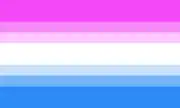| Sexual orientation |
|---|
.svg.png.webp) |
| Sexual orientations |
| Related terms |
| Research |
| Animals |
| Related topics |
|
| Part of a series on |
| LGBT topics |
|---|
|
|
| Flag | |
|---|---|
 {{{flag_name}}} |
Bi-curious (sometimes Bicurious) is a term for a person, usually someone who is a self-identified heterosexual, who is curious or open about engaging in sexual activity with a person whose sex differs from that of their usual sexual partners.[1][2][3] The term is sometimes used to describe a broad continuum of sexual orientation between heterosexuality and bisexuality.[4] Such continuums include mostly heterosexual or mostly homosexual, but these can be self-identified without identifying as bisexual.[5][6] The terms heteroflexible and homoflexible are mainly applied to bi-curious people, though some authors distinguish heteroflexibility and homoflexibility as lacking the "wish to experiment with sexuality" implied by the bi-curious label. It is important when discussing this continuum to conclude that bisexuality is distinct from heterosexuality and homosexuality rather than simply an extension of said sexualities like the labels heteroflexibility and homoflexibility would imply, due to the prominent erasure and assimilation of bisexuality into other identity groups.[5] To sum it up, the difference between bisexual and bicurious is that bisexual people know that they are sexually attracted to both genders based on personal experience. Bicurious people are still maneuvering their way through their sexuality.[7][8]
Bi-curious is not to be confused with forms of sexual fluidity, defined as a "capacity for situation-dependent flexibility in sexual responsiveness,"[9] as bi-curious implies the existence of one set sexuality for the individual who carries the label, even if it is currently unknown, rather than an acknowledgment that the individual's sexual preference has changed and will continue to change that comes with sexual fluidity.
Bi-Curiosity and other non-monosexual identities
Standard theories of bi-sexuality make use of the term bisexual umbrella to encompass multiple other non-monosexual identities (sexual identities that allow for multiple gender identity possibilities in partners)[10] that are possible outcomes of exploration for bi-curious people. However, similar on the surface, bisexuality and the subsequent elements of its umbrella are distinct, thus leading to the possibility that a currently bi-curious person may end up as neither bisexual, homosexual, or heterosexual, but another non-monosexual identity altogether.[11] This umbrella can be better broken into binary and non-binary sexual identities, with bisexuality being a 'binary' sexual identity, meaning it is an attraction to men conventionally and women conventionally (a combination of the binary sexual attractions of homosexual and heterosexual). At the same time, pansexuality is a non-binary sexual identity because it is an attraction to an individual regardless of what gender identity they label themselves, including men, women, non-binary people, gender-fluid people, and more.[12] The relevance to a bi-curious person is at what range does their exploration end; have they found that their sexual attraction ends with both men and women (binary sexual attraction), or do they find themselves attracted to individuals regardless of their gender identity (non-binary sexual attraction).[13]
Etymology
The term started becoming popular after 1984, according to Merriam-Webster, but The New Partridge Dictionary of Slang and Unconventional English and Oxford Dictionaries' Lexico claim that the term was coined in 1990.[14] According to Dictionary.com, the term was first used between 1980 and 1985.[15]
See also
References
- ↑ "Definition of BI-CURIOUS". www.merriam-webster.com. Retrieved 2019-09-21.
Characterized by an openness to or curiosity about having sexual relations with a person whose sex differs from that of one's usual sexual partners : curious about exploring or experimenting with bisexuality.
- ↑ Wilson G, Rahman Q (2008). Born Gay: The Psychobiology of Sex Orientation. Peter Owen. p. 15. ISBN 978-1784506636.
The term 'bi-curious' refers to that fact that many people who are basically straight might consider an occasional homosexual adventure simply to broaden their horizons.
- ↑ Holleb ML (2019). The A-Z of Gender and Sexuality: From Ace to Ze. Jessica Kingsley Publishers. p. 43. ISBN 978-1784506636.
Someone who considers themselves heterosexual but has a sexual or romantic 'curiosity' toward the same gender.
- ↑ Frank, Katherine (August 2008). "'Not Gay, but Not Homophobic': Male Sexuality and Homophobia in the 'Lifestyle'". Sexualities. 11 (4): 435–454. doi:10.1177/1363460708091743. ISSN 1363-4607.
- 1 2 Ross, Lori E.; Salway, Travis; Tarasoff, Lesley A.; MacKay, Jenna M.; Hawkins, Blake W.; Fehr, Charles P. (2018). "Prevalence of Depression and Anxiety Among Bisexual People Compared to Gay, Lesbian, and Heterosexual Individuals:A Systematic Review and Meta-Analysis". Journal of Sex Research. 55 (4–5): 435–456. doi:10.1080/00224499.2017.1387755. ISSN 1559-8519. PMID 29099625.
- ↑ Savin-Williams, Ritch C.; Joyner, Kara; Rieger, Gerulf (2012-02-01). "Prevalence and Stability of Self-Reported Sexual Orientation Identity During Young Adulthood". Archives of Sexual Behavior. 41 (1): 103–110. doi:10.1007/s10508-012-9913-y. ISSN 1573-2800.
- ↑ Smorag, Pascale (14 May 2008). "From Closet Talk to PC Terminology: Gay Speech and the Politics of Visibility". Transatlantica (1). doi:10.4000/transatlantica.3503. Retrieved February 13, 2011.
- ↑ "What Is Bicurious?". WebMD. Retrieved 2022-02-19.
- ↑ Diamond, Lisa M. (2016-12-01). "Sexual Fluidity in Male and Females". Current Sexual Health Reports. 8 (4): 249–256. doi:10.1007/s11930-016-0092-z. ISSN 1548-3592.
- ↑ "LGBTQ Plus Glossary". health.ucdavis.edu. Retrieved 2023-11-29.
- ↑ Flanders, Corey E.; LeBreton, Marianne E.; Robinson, Margaret; Bian, Jing; Caravaca-Morera, Jaime Alonso (2017-01-02). "Defining Bisexuality: Young Bisexual and Pansexual People's Voices". Journal of Bisexuality. 17 (1): 39–57. doi:10.1080/15299716.2016.1227016. ISSN 1529-9716.
- ↑ Sprott, R. A. (2018). "Bisexuality, pansexuality, queer identity, and kink identity". Sexual and Relationship Therapy. 33 (1–2): 214–232. doi:10.1080/14681994.2017.1347616. Retrieved 2023-11-29.
- ↑ McShane, H. (2019). "The Bisexual To Be Corrected: Interrogating The Threat And Recuperation Of Women's Femme Bisexuality". S2CID 203065136.
{{cite journal}}: Cite journal requires|journal=(help) - ↑ "What Does It Mean To Be "Bi-Curious"?". Refinery29.
- ↑ "bi-curious". Dictionary.com. Retrieved 2022-04-02.